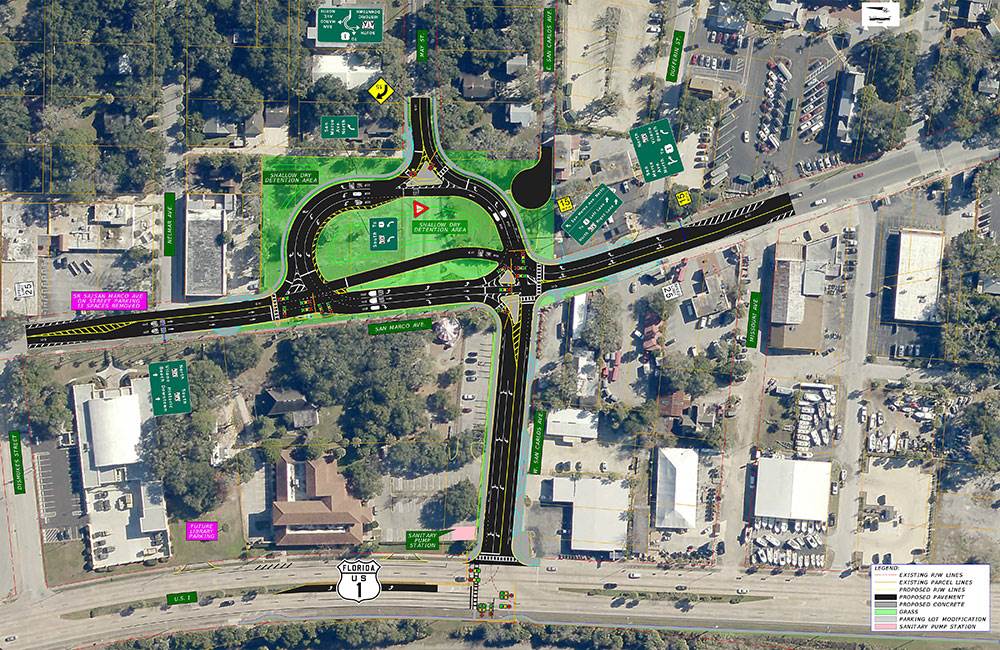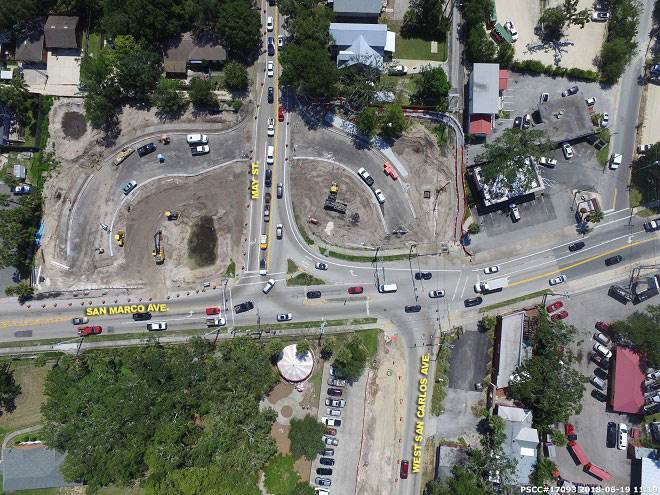Most communities across the U.S. have at least one of these: problem intersections. You know the ones. They’re usually not hard to spot, and they are challenging to navigate if you’re driving or walking.
They’re often characterized by long lanes of backed-up traffic, temperamental traffic signals, unsafe or difficult left turns and traffic incidents.
The city of St. Augustine in northeastern Florida, the nation’s oldest city, had its own problem intersection, which caused headaches for drivers, as well as safety concerns for motorists and pedestrians.
The State Road A1A/San Marco intersection is a gateway entrance to St. Augustine’s historic downtown and an important connection to U.S. 1, SR A1A, as well as the area’s beaches, neighborhoods, businesses and the Florida School for the Deaf and the Blind (FSDB). This intersection sees a high volume of traffic, including sightseeing trolleys, semitrucks and vehicles pulling boat trailers.
U.S. 1, San Carlos Avenue and May Street all converged at San Marco Avenue to form two adjacent signalized intersections. This area often became a bottleneck, with traffic backing up several hundred yards in all directions, including onto a nearby bridge. Besides the mounting traffic congestion and frustration caused by these intersections, the city of St. Augustine and the Florida Department of Transportation (FDOT) District Two were focused on the safety of motorists, pedestrians and bicyclists traveling through this busy, challenging juncture.
In a September 2018 article in First Coast News, Jessica Clark wrote, “After years of frustration, one of the busiest intersections in St. Augustine is finally getting a much-needed facelift.”
Indeed, it was. And Hanson was ready to help the city and FDOT transform the look of the intersection and improve its safety and functionality.
FDOT figures out feasible fix
During the initial planning process, which started with five alternatives, the public asked FDOT to explore more options. Discussions about how to improve the intersection had been ongoing, and community members were actively involved in the evolution of this improvement — calling for new alternatives to improve not only the traffic congestion but their community’s overall infrastructure.
FDOT District Two’s Urban Planning and Modal Administrator, Jim Knight, P.E., came up with an innovative approach. He shared his original concept sketch with Hanson, and we used microsimulation analysis tools to validate the concept. Our analysis proved his creative idea could reduce conflict points and traffic queue lengths and decrease traffic signal phasing from four signals to two, allowing traffic to flow more smoothly.

The unique concept developed for the SR A1A/San Marco intersection improvements in St. Augustine, Florida, by Florida Department of Transportation District Two’s Urban Planning and Modal Administrator Jim Knight, P.E., was used as the basis for Hanson’s microsimulation analysis. The concept was overwhelmingly accepted by the city, stakeholders and public.
The design involved separating two adjacent signalized intersections to form a single quadrant/offset T-intersection. This included realigning the SR A1A (May Street) intersection at San Marco Avenue, dividing SR A1A into two legs, adding dual left-turn lanes along West San Carlos Avenue and extending a left-turn lane along U.S. 1.
This project also involved numerous design elements. These included lighting, which was brought up to new intersection standards, 10 new signal mast arms designed to meet hurricane-force winds, the first High-intensity Activated crossWalK (HAWK) crossing in northeast Florida, redundant traffic signals, visual and audible pedestrian signals and the signage and striping to address the unique lane configurations.
The addition of dedicated right and left turn lanes, median modifications, synchronized traffic signals, sidewalks, shared bicycle lanes and HAWK pedestrian signals improved traffic flow and safety for pedestrians and bicyclists.
Collaboration with community leads to enhancements in safety, accessibility
Throughout this project, the project team worked closely with the FSDB, which is a public school for pre-K and K-12 students who are deaf or hard of hearing, blind or visually impaired or deafblind. The school serves more than 1,000 children on its 80-acre campus less than three blocks away on San Marco Avenue.

Construction is underway for the reconfiguration and relocation of the San Marco and May Street intersection, while motorists continue to travel using the original intersection.
This collaboration was important throughout the design process and led to the installation of two HAWK signals at a new pedestrian crossing. Designers incorporated a delicate balance of sound into the HAWK system and other pedestrian signals to accommodate FSDB students, neighbors and other pedestrians who use this crossing. As part of the HAWK system, pedestrians hear a prompt that announces the crossing street name. These prompts are designed to be loud enough for FSDB students to hear and allow for the audio level to be lowered at night to reduce disturbances to surrounding residential neighborhoods.
In addition to a challenging roadway design, utility conflict resolution and signing and marking, the highly visible project included the design of a new closed drainage collection system to help alleviate a chronic flooding problem, a stormwater management facility, new utilities, environmental permitting, cultural resources and significant public involvement.
“This project showcases the positive outcomes that can occur when engineering and transportation professionals listen to the needs of their clients and communities, engage with them and work together to create a solution that improves safety, travel and quality of life,” said Hanson’s project manager Chantal Bowen, P.E.

This intersection is an important connecting point for U.S. 1 and SR A1A, providing access to historic downtown St. Augustine, the area’s beaches, neighborhoods and businesses and the Florida School for the Deaf and Blind. Today, the new intersection is able to accommodate a higher volume of traffic, safely and efficiently.
Innovative, unconventional design gives intersection a green light
The U.S. 1/SR A1A San Marco intersection was completed in September 2021 and accommodates a much higher volume of traffic than before.
“The project team met an accelerated design schedule for this dynamic and fluid project. As the scope expanded, so did the project team’s commitment to designing a solution that would exceed FDOT District Two’s goals, as well as the expectations of the city of St. Augustine, the public and stakeholders. We accomplished this through innovative design, collaboration, public meetings and a focus on multimodal transportation and safety,” Bowen added.

This concept improved the safety and usability of the SR A1A/San Marco intersection and changed the way FDOT’s District Two approaches intersection design projects by considering innovative, creative ways to improve intersections, traffic phasing and signalization.
“This unique design reflects how FDOT District Two is moving beyond standard intersection design to improve traffic flow and safety. The project is indicative of the types of positive transportation improvements FDOT District Two strives for in our communities, using partnerships with affected entities, providing the best value to stakeholders and our constituents,” said FDOT’s District Two Director of Transportation Robert L. Parks, P.E.
For more information about this project or how Hanson can help you with a project that is important to you and your community, contact Chantal Bowen, P.E., at cbowen@hanson-inc.com.